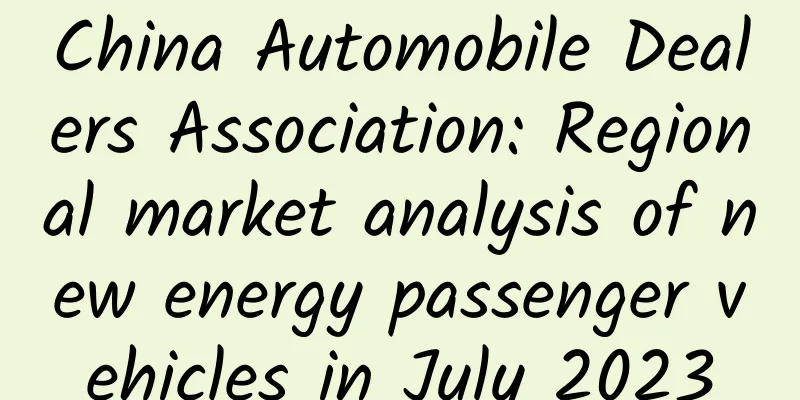China Automobile Dealers Association: Regional market analysis of new energy passenger vehicles in July 2023

|
July is a month of seasonal weakness in the new energy vehicle market. Domestic retail sales fell slightly from June, but exports continued to grow strongly. Consumer upgrades and replacements for plug-in hybrids grew rapidly, so the replacement of new energy vehicles in July was strong, driving the strong growth of plug-in hybrids. From January to July, new energy passenger vehicles achieved a strong positive growth of 42%, which was also a good performance that exceeded expectations. New energy vehicle wholesale is strong in July In July, wholesale sales of new energy passenger vehicles reached 740,000 units, a year-on-year increase of 30% and a month-on-month decrease of 3%. From January to July, the wholesale sales of new energy passenger vehicles reached 4.3 million units, a year-on-year increase of 42%. Since the beginning of this year, the price of power batteries has been on a downward trend due to the decline in raw materials such as lithium and nickel, which is conducive to enterprises reducing production at the beginning of the year, reducing historical inventory, and achieving strong growth in new products. China's sales volume from January to July was strong, reflecting good demand for new energy vehicles and still has potential for growth in the future. New energy vehicle retail sales grew strongly in July In July, the new energy vehicle market sold 640,000 vehicles, a year-on-year increase of 32% and a month-on-month decrease of 4%. The cumulative retail sales so far this year reached 3.74 million, a year-on-year increase of 37%. The trend of new energy vehicles in July was relatively strong, and the inhibitory effect of the promotion of fuel vehicles was not strong. New energy vehicle exports grew strongly in July In July, 88,000 new energy passenger vehicles were exported, which is very good considering Tesla's low exports at the end of the quarter. More and more Chinese-made new energy product brands are going abroad, mainly targeting developed countries due to the continuous improvement of overseas recognition and the improvement of service networks, so the market prospects are good. From January to July, the cumulative exports reached 570,000 units, a year-on-year increase of 1.5 times. From the monitoring of retail data of independent export markets, independent brands such as SAIC performed strongly in Europe. In addition to the good performance of traditional export automakers, the export of new forces has also gradually started recently, and data from overseas markets have also begun to emerge. The low base in July has increased the promotion of exports, and the export of new energy vehicles is expected to continue to grow at a high level in the next few months. The contrast between traditional cars and new energy vehicles This chart is a 1:3 ratio, which clearly shows the contrast between traditional cars and new energy vehicles. New energy vehicles have risen sharply, while traditional cars have recovered slowly. The trends of pure electric and traditional cars are relatively differentiated. The trends of plug-in hybrid and hybrid are also strong. The trend of fuel vehicles in July was strong, higher than the sales in March. Plug-in hybrid new energy vehicles continued to strengthen significantly in July. Extended range performance is also strong. Usage characteristics of new energy passenger vehicles The proportion of new energy passenger car rental and leasing gradually increased from 2018 to 2019, and then the proportion of pure electric rental and leasing continued to decline starting in 2020. This year's market demand has gradually stabilized, and the proportion of pure electric rental and leasing in July 2023 was 12.1%, a slight increase from the beginning of the year. The proportion of plug-in hybrid vehicles in the private market has continued to increase recently, while the demand for plug-in hybrid vehicles for rental has continued to decline. Pure electric vehicles are still the best choice for rental. The proportion of pure electric vehicles for rental in July remained at a recent high. Regional market performance is gradually improving In the past few years, the demand for new energy passenger vehicles was strong mainly in megacities with purchase restrictions, but has continued to decline recently. In 2023, new energy passenger vehicles accounted for 20% of total sales in megacities, down 3 percentage points from 2022. This also shows that the sales growth rate of new energy vehicle market in cities with purchase restrictions has gradually slowed down, and the basic population size has constrained demand. Due to the large population base and poor public transportation, the market demand in large and medium-sized cities has been strong recently, and new energy in county and township markets has gradually started. Excluding the special factors of purchase restrictions in megacities, the growth of the auto market is mainly in medium-sized cities and counties and towns. Compared with the gradual extension of fuel vehicles to the lower county-level market, the pace of new energy vehicles is faster, especially in large cities without purchase restrictions, where new energy vehicle sales have reached a relatively high share. Plug-in hybrid models in the county and township markets are also gradually expanding, with great potential in the future. The performance of the new energy urban market is gradually improving The main growth of new energy vehicles in July was in the hardest-hit areas of the epidemic that were suppressed in the early stage, and the restricted purchase areas such as Shanghai and Shenzhen performed poorly. The main growth of new energy vehicles in July also included Wuhan and non-restricted core cities such as Chongqing and Zhengzhou. The decline was in market areas such as Jiaxing and Chaozhou. In 2023, new energy vehicles will still grow significantly compared to the same period in 2022. The growth in Shanghai, Guangzhou, Zhengzhou, Chengdu, Hangzhou and other cities will be relatively rapid, forming the core driving force for the increase. The Chengdu market is also a unique environment for new energy vehicles to show high growth. Products with high appearance and low use costs have great potential in the southwest region. Wuhu, Foshan and other places performed relatively poorly and did not contribute to the growth. Regional differences in demand for electric vehicles The gradual launch of the pure electric private household market has promoted the development of the industry. Although the demand in large cities with purchase restrictions is very strong this year, its share has gradually decreased, the market share of large and medium-sized restricted cities has continued to rise, and the private consumption market in small cities and county and township markets has recovered slowly. The pure electric vehicle leasing market is currently showing a gradual recovery. In 2019, the proportion of rental and leasing in pure electric vehicle sales reached its peak, and then the proportion of rental and leasing declined in 2020. In 2021-2022, the performance dropped to around 15%, but rebounded to 17% in July 2023, among which the proportion of cities with purchase restrictions and large cities increased rapidly. The proportion of rental cars in cities with purchase restrictions and medium-sized cities has increased recently, and the private market in medium-sized cities is still growing rapidly. This year, the rental market in large cities without purchase restrictions is relatively large. From the performance of the main models, it also reflects the improvement of the performance of the main models in large and medium-sized cities, especially the increase in BYD in July, which increased by 1-2 percentage points compared with the same period. From the perspective of Tesla, the main area in July extended to the small and medium-sized city market compared with the same period, and the pure electric market in super-large cities grew relatively well. Regional Demand for Plug-in Hybrid Passenger Vehicles The private consumption market for plug-in hybrid vehicles has great potential for growth, and there is good demand in both small and medium-sized cities. The proportion of plug-in hybrid vehicles in unit use and rental continues to shrink. The main demand for plug-in hybrid rental models is in the megacities and large cities, and this year's megacities have seen a significant decline in plug-in hybrid rentals. In recent years, the proportion of plug-in hybrid vehicles in cities without purchase restrictions has gradually increased, and BYD and Ideal are relatively strong. Ideal L7 performed very well in July, surpassing some old star models. Plug-in hybrids strengthened in July. Large and medium-sized cities without purchase restrictions remained the main force of plug-in hybrids. The proportion of demand in cities with purchase restrictions declined, and plug-in hybrids in county and township markets received a good boost. The dependence of BYD Han and other models in cities with purchase restrictions has decreased, while low-priced plug-in hybrid models such as Qin and Song have performed well in small and medium-sized cities. Regional penetration of electric passenger vehicles – July At present, the proportion of pure electric vehicles in cities with purchase restrictions has increased significantly, from 10% in July 2020 to 32% in 2023. The sales share of pure electric vehicles of new energy vehicles in large cities, medium-sized cities and small cities without purchase restrictions is basically the same. In 2019 and 2020, it was at a relatively low level. In July this year, it rose to 23% in medium-sized cities, and the penetration rate in county and township markets was also strong. The market penetration rate of plug-in hybrids continues to grow across the country, especially in megacities. In July this year, the market share of plug-in hybrid vehicles reached 11%; the share of the plug-in hybrid market in small and medium-sized cities also showed a continuous upward trend, and the gap in plug-in hybrid penetration rates between different types of cities has narrowed relatively. In Shanghai, the plug-in hybrid market accounted for 4% in July, a significant decline, driven by the plug-in hybrid license policy. The plug-in hybrid markets in Shenzhen and Hangzhou also saw a significant month-on-month decline in July. The companies in each regional market are highly differentiated The performance of the rental markets in various regions varies greatly. The rental markets with strong performance in July this year are Guangdong, Zhejiang, Jiangsu, etc. Among them, the performance of various manufacturers in the rental markets in various regions is also quite different. The market share of local products in some regions is not necessarily very high. The private pure electric market has relatively distinct characteristics, and the trend towards high-end is extremely obvious. BYD performed well, and it basically ranked first in developed regions such as Guangdong, Jiangsu, and Zhejiang. New car manufacturers such as NIO and Xpeng Motors have performed very well, while traditional car manufacturers have also performed well in the private electric vehicle market. BYD and Li Auto performed well in the private plug-in hybrid market, especially in BYD's main cities, where it was in the lead and Li Auto ranked second. Changan and Great Wall also performed well. Since the plug-in hybrid market outside of BYD is mainly extended-range, the private plug-in hybrid performance of joint venture automakers is relatively weak. Beijing Market Trends The trend of the new energy vehicle market in Beijing in 2022 was relatively stable, with sales reaching 25,000 units in July 2023, significantly higher than the same period last year, and the license plate indicators were fully digested. The cumulative sales in 2023 increased by 36% year-on-year, which was a good performance. Since the new energy vehicle quota became relatively tight in 2018, the Beijing new energy vehicle market in 2022 has been in contrast to the national trend. The current growth rate is relatively low. Some users who bought cars in 2018 should change their cars, but the total market volume is still not high. This is the effect of suppressed consumption caused by the rhythm of quota issuance. Beijing's new energy vehicle sales were relatively good from June to September last year. Considering the lack of quotas and the small supply of Tesla vehicles, Beijing's performance in July was also relatively strong. Beijing's new energy vehicle grades are generally pragmatic, which is also a reflection of the good demand for household use. Shanghai New Energy Market Trends The new policy trend in the Shanghai market is in sharp contrast to that in the Beijing market, which has been extremely stable since 2019. In July 2020, the year-end rush to buy began to appear. Sales in July this year fell significantly, and Shanghai's new energy vehicles showed a sustained growth trend. In July 2023, sales of new energy vehicles in Shanghai reached 24,000 units, a 10% decrease from 27,000 in July last year. The losses suffered by Shanghai's new energy vehicles due to the epidemic last year have now recovered significantly, and the end of the license rush has little impact. Market trends of new energy passenger vehicles in restricted cities New energy vehicles performed relatively strongly in restricted cities, reaching 154,000 units in July 2023, with a year-on-year growth rate of 41%, a good level. The cumulative sales of new energy vehicles in 2022 reached 1.32 million, a year-on-year increase of 94%, which is much higher than the overall growth of our auto market and higher than the average growth rate of our overall new energy vehicles, reflecting the relatively high enthusiasm of restricted cities to purchase new energy vehicles. Market trends of new energy passenger vehicles in areas with no purchase or driving restrictions Non-double-restricted cities refer to areas where there are no restrictions on the purchase and use of fuel vehicles. Since there are no restrictions on the purchase and use of traditional vehicles, the demand for new energy vehicles in these cities is real market demand. At present, the number of non-double-restricted cities is also growing rapidly. This type of city is relatively large in the country, and the sales of new energy vehicles are currently at a relatively high level. In 2022, the total sales in non-dual-restricted cities reached 2.74 million units, a year-on-year increase of 96%, showing a strong growth trend. In 2023, the performance of new energy vehicles in non-dual-restricted cities was extremely good, with sales of 338,000 units in July, a growth rate of 48%. Cities without purchase and driving restrictions, which were not affected by the policy in the early stage, have become the main force of sales and growth. All regions in the country have strong demand growth for new energy vehicles. Combined with the demand in cities with driving restrictions, regional market demand in 2023 will maintain strong growth. |
<<: Who is the number one mobile phone in China?
>>: Google Fiber's 1Gbps Internet speed is accused of hype
Recommend
How to plan the core selling points of a brand? One model to get it done
The company's new brand is about to enter the...
Earth Hour: If you want to make the earth "easier", you can do these things →
The "Earth Hour" event is a global even...
New iPhones every year, but old scalpers every year: China's shameless buyers
The huge logo of Apple's Fifth Avenue flagshi...
Logical analysis of bidding coefficients for competitive bidding promotions!
In the work of bidding promotion , you will often...
Construction safety engineering PPT dynamic slide template decoration design plan summary work report Baidu cloud download
Construction safety engineering PPT dynamic slide...
How to make reasonable use of 3 types of ground promotion methods?
A few days ago, when I passed the Gaoxinyuan subw...
Quick guide to host live broadcast!
1. The difference between live broadcast and live...
New iPhone feature: Operate all apps remotely
The practical functions of domestic mobile phones...
When the whole world is talking about Swift open source - 2015 Objective-C new features
Overview Since the launch and open source of Swif...
Shared air conditioners: home appliance sharing is either a narrow alley or a dead end
Shared washing machines and shared televisions ha...
What are some tips for new Tik Tok live broadcasts to avoid dull audiences?
For many new Douyin users, they naturally hope to...
NASA finally admits! Going to Mars is to search for alien life
As to whether there is extraterrestrial life in t...
Big news! WeChat suddenly released the "WeChat Index" last night: a must-read for operators, advertisers laughed, Baidu cried again...
Just last night, something happened that had far-...
H5 Marketing from a Novice to an Expert: 5 Steps to Teach You How to Create an H5 Plan with Millions of Users!
Mentor: Qiao Xinhua, Senior Product Manager at Pe...
Can prolonged use of mobile phones cause cerebral infarction? These habits are no joke!
Expert of this article: Wang Li, attending physic...









